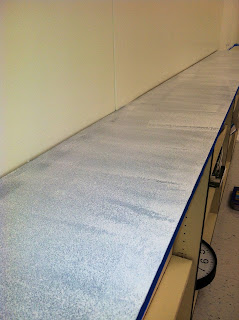We were able to complete the entire back wall before he had to leave at 1:00. I took a short break, and was back to work by 1:30. I worked for another three hours afterwards, mixing and painting, until finally, seven hours after I'd begun, the walls were finally finished.
Before I post pictures, the top five things I learned from the experience, in no particular order.
1) They aren't kidding when they tell you about the odor. It is intense as I've ever experienced, even wearing a mask.
2) WEAR GLOVES. This was the one item I forgot at Ace Hardware, and it came back to bite me. IdeaPaint is not like any other paint; the bond it forms with whatever surface it touches is very hard, and very strong. Even the denatured alcohol that IdeaPaint recommends was unable to do the trick. Eventually I found that a strong exfoliant wash, a pumice stone, and hot water were able to, over time, get the paint off.
3) Have denatured alcohol on site to pick up spills and splatters. I didn't have it on site, so I'm sure there will be some scrubbing involved to clean up the 'Oops" moments.
4) Recruit some help. I am grateful for the help Austin gave me, but I needed to have asked for help long before, and a simple two or three day project took a week, and dozens of hours of labor.
5) IdeaPaint is a tricky little devil sometimes. The instructions are very explicit not to try to spread it too thin, to make your 50 sq. ft. kit actually cover 50 sq. feet. The issue is that this stuff has the consistency of milk, and spreads incredibly easy. I found the kits lasting longer than I wanted them to. On the first wall we painted (the back wall), I had to fudge on the instructions and go back and repaint sections that I were afraid had inadequate coverage. It is supposed to be a single-layer applied paint, so I'm really hoping this isn't a deal breaker. I back rolled as best I could to try to ensure even consistency, but the wall in question still looks "streaky" in spots. To try to ensure a good writing surface, I'm going to let the wall cure for ten full days instead of the required seven.
Enough talking, here are the pictures. Because of the liquidy consistency of the paint, we did have a couple of spills/ splatters, which will need to be picked up, but I'm far too exhausted to deal with that right now.
I was impressed by the glossy finish and the sharp lines.
I felt really good about this wall in particular.
A closer image of the high-gloss surface, with an "oopsie" next to it.
Another wall I felt I did very well. Last wall I painted.
This is the wall I'm concerned about. If you look closely, you can see a lack of uniformity, or "streakiness," in certain spots. I don't mind this as long as it doesn't affect the writing performance. If it does, I guess I'll have to re-do this whole wall. Live and learn.
So now the waiting game begins. I'm going to allow ten days for the wall to cure before writing, which would put "The Day" at July 9th.




















